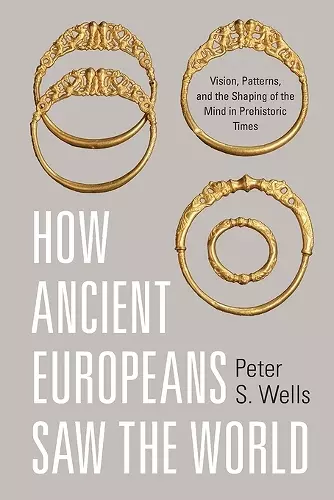How Ancient Europeans Saw the World
Vision, Patterns, and the Shaping of the Mind in Prehistoric Times
Format:Paperback
Publisher:Princeton University Press
Published:17th Jul '15
Currently unavailable, and unfortunately no date known when it will be back
This paperback is available in another edition too:
- Hardback£42.00(9780691143385)

The peoples who inhabited Europe during the two millennia before the Roman conquests had established urban centers, large-scale production of goods such as pottery and iron tools, a money economy, and elaborate rituals and ceremonies. Yet as Peter Wells argues here, the visual world of these late prehistoric communities was profoundly different from those of ancient Rome's literate civilization and today's industrialized societies. Drawing on startling new research in neuroscience and cognitive psychology, Wells reconstructs how the peoples of pre-Roman Europe saw the world and their place in it. He sheds new light on how they communicated their thoughts, feelings, and visual perceptions through the everyday tools they shaped, the pottery and metal ornaments they decorated, and the arrangements of objects they made in their ritual places--and how these forms and patterns in turn shaped their experience. How Ancient Europeans Saw the World offers a completely new approach to the study of Bronze Age and Iron Age Europe, and represents a major challenge to existing views about prehistoric cultures. The book demonstrates why we cannot interpret the structures that Europe's pre-Roman inhabitants built in the landscape, the ways they arranged their settlements and burial sites, or the complex patterning of their art on the basis of what these things look like to us. Rather, we must view these objects and visual patterns as they were meant to be seen by the ancient peoples who fashioned them.
Honorable Mention for the 2012 PROSE Award in Archeology & Anthropology, Association of American Publishers "[B]eautifully crisp and elegant... [Wells's] book deserves to be widely read and admired."--Peter Thonemann, Times Literary Supplement "With painstaking detail, Wells documents how objects tell the early European story, making a compelling case that historians ought to rethink the standard views."--Tom Siegfried, Science News "Archaeologist Wells takes a novel approach to exploring the way Bronze and Iron Age societies in Europe (2000BCE to 1CE) viewed themselves. Through analysing their artifacts, pottery, fibulae, swords and scabbards, and coins, as well as the arrangements of their graves and their public places, the author plausibly suggests that their views changed through time."--Choice "It is evident that Wells is constantly conscious of the fact that he is writing for a modem 'literate' person to who words are more important than visuals. He has explained every single object, without going on jargons. An interesting history of Europe."--R. Balashankar, Organiser "How Ancient Europeans Saw the World offers a completely new approach to the study of Bronze Age and Iron Age Europe, and represents a major challenge to existing views about prehistoric cultures."--World Book Industry "Wells presents thought-provoking ideas about Bronze Age and Iron Age Europeans. This book will stimulate further research on a very challenging topic, that is, the mindset of past populations. The extensive bibliography is very useful for archaeologists interested in this type of research."--Sarunas Milisauskas, Historian "This book is thought-provoking; its broad geographical scope is particularly relevant in this post-credit-crunch world where European integration is once more on the agenda."--Laura Slack, Time & Mind
- Commended for PROSE Awards: Archeology & Anthropology 2012
ISBN: 9780691166759
Dimensions: unknown
Weight: 454g
304 pages